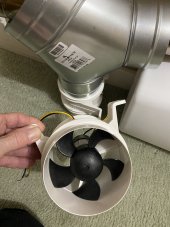The only thing to be aware of is that a DC motor rheostat and a dimmer for an AC light are two different things. If you do the test run on the AC fans that you have now you'll be able to guesstimate the amperage draw of the adjustable DC fans, roughly. The only way to get more accurate numbers is to actually build the system with the DC parts and check via shunt or power meter what you're actually drawing.
In short, yes. Throw some rheostats on those to control the speed needed and you'll save power draw prolonging the feed time of the batteries. Building for worst case scenario can only benefit you now that you've got a rough idea of what that would be.

EXCELLENT...RedNeckTek See your message here with my comments in "(((" yada yada yada ")))" Triple brackets. THANKS!!
So, it's just a math problem. You'll need 5Ah of battery per hour of burning so worst-case scenario would be 24hr X 5Ah = 120Ah/Day @ 12v = 1440wh of power
That's easy, if you go LiFe battery you'll need 144Ah or 1728Wh of power per day which means a 200Ah battery (or 2x 100Ah in parallel) which I recommend because of the sheer number of batteries required for feeding that system for a few days. Optimally 3 or 4 of the 200Ah batteries just for longevity.
(((LiFePo I surfed that they are pricey, huh?!)))
You
COULD use FLA or AGM batteries, but 1: they're only 50% DOD so you'll need twice as many batteries which is heavy and takes up a lot of space and 2: they're not usually available over about 100Ah which means twice as many batteries again. In short, you'll need 4 AGM's to replace a single 200Ah LiFe battery.
Panel wise, and I don't know how much sun you have available in winter, I'd say get a 60a MPPT controller and 800w of panel figured out either large modern panels or lots of smaller panels on a ground mount or something. Physics come into play here more than anything else. At 60a and a 12v system you'll only be able to collect a max of 720w and it'll take at least 3 hours of good sun to recover what your fans have used up. Fortunately, there's nothing wrong with using multiple controllers and panel arrays in parallel to charge faster, you just run into physics and finances issues at that point.
(((YUP, Dollars and Donuts…bunches! Hmmmmmmmmmmmmmmmm?!?!?)))
As to
HOW to get the power out from there, an automotive bus block would be the best way to go. A 5a fuse to feed each fan, a switch to turn them on and off, and it will give you the ability to pipe out to other 12v devices, like USB chargers and lights and such. You might not get very good signal on the phone if SHTF but emergency alerts will still be happening and it's also a handy flashlight. Lights are also important as feeding a fire gets really hard if you're cutting kindling in pitch black darkness.
(((Good point I do have enough batteries to put a dent in failure to survive…but your point is well accepted and agreeable)))
Connecting up the batteries I would recommend using a bus block and connecting each battery individually. That way if you need to pull a battery to charge elsewhere you can disconnect and pull a battery without disturbing the other ones and the system would continue to run everything.
OK, does that make sense to anyone else?
Now, there are a couple of things that can be done to help make the process a bit more efficient but not much. The first thought in my head was "Do you really need fans that powerful?"
(((I was wondering about computer fans but have not tried them—perhaps I should. I also have these real cheap 4inch fans that came with a little 5 square solar panel and hooked them to a bigger panel…I thought they would fly south they ran so fast…ha ha ha. I could duct them and use them in place of the pictures large AC fan (!?!?!).))) 200CFM is a LOT of airflow and that air has to come from somewhere, just as likely to be your fire box which means you'll be going through wood like crazy
(((Yes that would be true except that if you look to the pictures and the #2 that ‘joint’ can be opened to allow more outside air in which would cause less ‘pull’ on the exhaust gases from the smaller stove pipe and stove (I believe, anyway) Also it is possible that I would ONLY have the fans on when loading wood because the small amount of pipe from the stove exit to the end of the hot pipe is not that long (3 vertical ft & 6 horizontal ft) and without the fan operating (at “the barn”) the stove worked quite well all by itself!))). Have you looked at Marine ductwork fans?
(((the two DC fans I have are marine bilge blowers—they are sort-ta cool…even cute ha ha ha… picture to follow))) Would a 100CFM fan still do the job? The smallest fan you actually need
(((I would like to try smaller fans—perhaps I’ll experiment))), and since you're using 2 do they
BOTH have to be 200CFM? Can your system work with, say, a 100CFM and a 50CFM? (The point being that any air you suck through the firebox that is beyond what smoke is produced is just blowing excess heat outside AND drawing extra amperage off your batteries. Might be something to look into.
(((You are absolutely CORRECT…This is sort-ta a ‘fun’ experiment which I also hope will never be needed…Biden’s antics and demented and delusional behavior is making me itchy – I’m 23 years military!!)))
Since you did your tests with 120v fans, I'd say grab a couple cheap dimmer switches from the hardware store, wire them into the fans, and re-run your test at the barn. Turn the fan speed down until the system isn't quite working right and that'll give you a rough idea of what kind of CFM you'll need. Were you able to turn the fans down about half? Maybe 100CFM's then. Did you get it down 3/4? 50CFM there. Started freaking out right out the gate? Yup, 200's needed. You might find you'll need significantly smaller fans than your 200CFM's you're planning now and the test will only cost you about $20 in parts and some time. If it means your draw drops by half, that's half the battery capacity you'll need for the same runtime.
(((Aaaaah! EXCELLENT LOGIC!! YUP, why didn’t I think of that!!?? Perfect logic perhaps I was breathing in too much of the stove smoke. Ha ha ha ha… I’m off to try again and with smaller fans. THANKS. Ultimately, with more tests and small CFM I’ll not need bunches of batteries and such thereby saving me money in the long-run)))
Just my thoughts. I like what you came up with, I just think it needs a little fine tuning for efficiency and optimal fuel burn time







